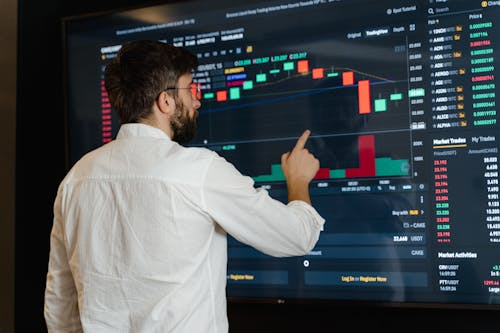Navigating Gold Futures

Gold has a way of revealing what the world is thinking. When markets grow uncertain, attention shifts toward it. Traders see it not as a relic of history but as an active, liquid instrument that responds to the rhythm of global events. Among the various ways to trade gold, futures contracts have become one of the most efficient. They offer scale, leverage, and constant movement.
Day traders are drawn to gold futures because the market never sleeps for long. Prices respond to every shift in sentiment, such as inflation data, central bank policy, energy prices, or even a tweet that changes how investors feel about risk. The challenge lies in understanding how these contracts work, what drives short-term fluctuations, and how to read the signs before the next move begins.
This guide is written for traders who want more than surface-level commentary. It breaks down the structure, the risks, and the tools that turn experience into discipline.

Our Mission
To make gold and crypto trading accessible by providing clear guidance, reliable information, and practical tools. We aim to support traders at every level with straightforward resources that simplify complex markets.

Our Vision
To become the most trusted online destination for gold and crypto trading education, helping traders worldwide grow their knowledge, improve their strategies, and stay ahead of market opportunities.

Understanding Gold Futures Contracts
How the Contract Works
Gold futures are standardized agreements traded on major exchanges such as the COMEX division of the CME Group. Each contract represents 100 troy ounces of gold, quoted in U.S. dollars per ounce. The purpose is not physical delivery but exposure to price movement. By opening a futures position, traders speculate on whether gold’s value will rise or fall within a defined period.
The price of gold futures moves in precise increments called ticks. Each tick equals ten dollars per contract. For someone holding a single contract, a one-dollar shift in price equals a gain or loss of one hundred dollars. This mathematical structure is what gives futures their appeal and their danger. The same leverage that can multiply returns can also amplify losses in seconds.
Exchanges require traders to post an initial margin, a good-faith deposit to open a position. This is followed by a maintenance margin, which ensures the account has enough equity to cover potential losses. When equity falls below the maintenance level, the trader receives a margin call and must add funds immediately or liquidate the position. These requirements are not arbitrary; they exist to maintain financial stability in a fast-moving market.
The Discipline Behind Margin and Exposure
Managing margin is central to survival in gold futures trading. Professionals think in terms of exposure, not potential profit. A trader might control a contract worth hundreds of thousands of dollars with only a fraction of that amount in margin. Without proper sizing, even a minor pullback can erase days of progress.
The emotional element can be intense. Watching unrealized gains vanish during a sudden price swing tests discipline more than any chart pattern. Traders who last in this market prioritize risk management. They size positions conservatively, avoid excessive leverage, and keep liquidity available to handle unexpected volatility. Consistency replaces impulse.
Understanding these mechanics gives traders confidence. It transforms futures from intimidating instruments into tools that reward preparation and patience. Gold’s volatility can be managed; what matters is adhering to the contract’s governing structure.
What Moves Gold Futures Each Day
Economic Signals and Market Psychology
Gold futures respond instantly to the global conversation about money, growth, and risk. The most predictable catalysts are economic data releases, such as inflation numbers, GDP reports, employment figures, and central bank policy statements. When inflation runs hotter than expected, investors often hedge by buying gold, anticipating that currencies will lose purchasing power. When yields on government bonds rise, the opposite can occur as traders shift toward interest-bearing assets.
This daily push-and-pull creates short bursts of volatility. Futures traders watch how the price reacts to each data point rather than the data itself. The initial reaction reveals market positioning and sentiment. A muted response after strong inflation data, for example, may signal that traders have already priced in the risk, leaving little fuel for a rally.
Beyond scheduled reports, gold also mirrors broader risk appetite. When stock markets decline sharply, futures often rise as investors reduce exposure to equities and seek perceived stability. Yet the relationship is not always linear. Confidence, liquidity conditions, and investor positioning can blur the usual patterns. The key lies in context: understanding why traders are reacting, not just that they are.
Geopolitical Pressure and Currency Influence
Political tension remains one of the strongest drivers of short-term movement. Conflicts, sanctions, or shifts in trade policy can spark immediate buying interest. During uncertain periods, traders treat gold futures as a temporary shelter, a way to hold value while assessing risk elsewhere. Once the situation calms, profit-taking often follows, leading to sharp retracements.
The U.S. dollar adds another layer. Because gold is priced in dollars, any decisive move in the currency directly affects futures prices. A weaker dollar usually supports gold, as it makes it cheaper for non-U.S. buyers, while a strengthening dollar tends to suppress demand. Skilled traders monitor currency charts alongside futures to anticipate these correlations.
In the short run, gold futures reflect the mood of global finance. They absorb fear, hope, and speculation in equal measure. Understanding those influences allows traders to respond with precision rather than react impulsively.
Reading the Market: Technical Insight
Patterns That Reflect Human Behavior
Technical analysis is less about lines and indicators and more about human behavior recorded on a chart. Gold futures traders rely on this visual language to understand where buying or selling pressure is building. Short-term participants often focus on one-minute, five-minute, and hourly charts because these intervals reveal how sentiment shifts over the course of the session.
Moving averages help filter random fluctuations. A short-term moving average crossing above a longer one may suggest momentum building in a particular direction, but context always matters. No indicator can replace experience. Traders observe how price interacts with these averages rather than treating every crossover as a signal. The goal is to sense rhythm, not react mechanically.
Oscillators such as the Relative Strength Index offer another layer of insight. They show when prices have moved too far in one direction within a short time, hinting at exhaustion. Still, overbought conditions do not automatically mean a sell-off. Skilled traders combine RSI readings with price action, noting whether momentum aligns with volume and structure.
Volume and Confirmation
Volume gives weight to every move. A surge in trading activity during a breakout often confirms commitment, suggesting that institutions or larger players are participating. When volume dries up, even a dramatic move can fade quickly. Futures traders monitor both absolute volume and its change relative to recent sessions.
Each chart carries a narrative. Sudden spikes, tight consolidations, and abrupt reversals all reveal emotion in motion. A thoughtful trader doesn’t chase every setup. They wait for alignment between price, volume, and timing before taking a risk. Over time, this process builds intuition. Gold may trade like a commodity, but on an intraday chart, it reflects human decision-making at its most concentrated. Recognizing those patterns gives technical analysis its actual value.
The Role of Timing and Volatility
Finding Rhythm in Global Trading Hours
Gold futures operate almost continuously, which means price behavior shifts as liquidity passes from one region to another. The market becomes most active when major financial centers open, particularly London and New York. During these windows, trading volume increases and spreads narrow, enabling smoother execution. For day traders, these periods provide the clearest information.
Thin hours, such as late in the Asian session or between U.S. close and European open, can be misleading. Price may drift in narrow ranges only to break sharply once participation returns. Recognizing this rhythm helps traders focus their energy on real opportunities rather than random ones. Success often depends on working with the market’s schedule rather than against it.
Timing extends beyond the clock. It involves knowing when to step aside. After major news releases or sharp price swings, liquidity can vanish temporarily. Professionals allow the market to stabilize before re-entering. This patience reduces the chance of chasing emotional moves created by short-term panic or greed.
Balancing Opportunity and Restraint
Volatility attracts traders because it creates action, yet it can also expose a lack of discipline. Gold futures can move several dollars within minutes when market sentiment changes. Some see this as potential profit; others recognize it as a test of composure.
The most consistent traders view volatility as information. Rapid movement tells them the market is seeking balance, not that every move warrants action. They adjust position size to reflect risk, accepting smaller gains in exchange for sustainability. The objective is not to capture every fluctuation but to participate selectively when conditions align with a defined plan.
This combination of timing, awareness, and restraint separates short-term speculation from skilled execution. Patience remains the most undervalued technical skill in gold futures trading.
Managing Risk and Leverage
Understanding Controlled Exposure
Leverage defines the futures market, but mastery comes from respecting its limits. A gold futures contract allows control over a significant notional value with a relatively small deposit. This efficiency appeals to traders seeking flexibility, yet it also demands precision. Each price movement carries amplified consequences.
Professionals treat leverage as measured exposure. They decide in advance how much of their capital to risk per trade, often a small percentage of total equity. By keeping exposure consistent, they reduce the emotional weight of any single outcome. This discipline prevents the temptation to chase losses or overextend after a win.
Margin requirements act as built-in safeguards. When volatility rises, exchanges increase required margins to protect participants from excessive risk. Traders who monitor these adjustments stay prepared. Those who ignore them can face forced liquidation when equity falls below maintenance levels. Risk control begins long before the order is placed.
Turning Consistency into an Edge
Every successful trader develops a method for preserving capital. Stop-loss orders are part of that method, not a sign of hesitation. They allow traders to define maximum loss before entering a position, ensuring that one mistake never spirals into disaster.
Routine evaluation also matters. Reviewing trade records, noting entry and exit quality, and assessing emotional decisions all help refine skill over time. Futures trading rewards those who think in probabilities rather than predictions. The goal is to protect capital so it can be used again tomorrow.
Experienced participants treat this process as a professional practice. They measure performance, adjust size, and remove emotion from decisions. Over many sessions, this consistency becomes their competitive edge. Profit is a byproduct of control, and control begins with respect for leverage.
How Information Shapes Sentiment
The Speed of Reaction
Gold futures reflect global sentiment with remarkable speed. The market reacts within seconds to data or headlines that shift expectations about growth, inflation, or safety. When a central banker hints at a policy change, prices may surge before the statement is finished. A sudden geopolitical headline can send futures soaring as traders rush to reposition their positions. This constant sensitivity makes gold one of the purest mirrors of human emotion in finance.
Because of this speed, traders must learn to distinguish genuine information from distraction. The modern market produces an endless stream of updates, forecasts, and opinions. Acting on every piece of news often leads to erratic decisions. The professionals who trade gold futures successfully do not chase noise. They learn to recognize which events have historical influence and which are simply commentary.
Even scheduled data, like inflation releases or employment numbers, can mislead if interpreted without context. The initial reaction is often emotional; the follow-through depends on how the broader market digests the result. The first move is noise, the second is information. Recognizing that distinction separates the skilled trader from the impulsive one.
Filtering and Timing Information
Reliable sources form the foundation of disciplined trading. Economic calendars highlight periods of potential volatility, allowing traders to prepare rather than panic. Verified financial news and official data feeds keep information accurate. Still, access alone is not an advantage. The edge lies in patience.
Many traders lose by reacting too soon. A measured approach means waiting for confirmation; a clear shift in price structure, volume, or correlation with related markets. Gold often reacts sharply, then settles. The professional waits for stability before entering.
Understanding sentiment is less about prediction and more about timing a response. When information is analyzed rather than absorbed emotionally, gold futures become less intimidating. The trader begins to operate on logic rather than on adrenaline.
Developing a Repeatable Process
Structure as a Form of Control
Successful trading depends on process, not intuition. Gold futures move quickly, and without a framework, it becomes easy to get lost in the noise. Traders who thrive build structure into their routine. Before each session, they review the previous day’s highs, lows, and closing behavior. They note how the price reacted to economic reports and where volume concentrated. This preparation shapes the day’s strategy.
During active hours, experienced traders set alerts for significant levels rather than staring at charts endlessly. They understand that patience protects energy. A well-planned alert system allows for focus on the right moments rather than random movement. These habits transform trading from guessing into decision-making.
A structured approach does not eliminate uncertainty, but it reduces the influence of impulse. Gold futures can swing dramatically; a framework keeps emotion from dictating action. Over time, this discipline becomes second nature, allowing the trader to act decisively without hesitation or regret.
Building Consistency Over Prediction
The market rewards consistency more than creativity. Many traders fail not because they misread direction, but because they trade without repetition. A repeatable process means executing the same type of setup, managing risk consistently, and analyzing results objectively.
Losses are inevitable, but with a defined process, they become data instead of defeat. Each outcome offers insight into whether the approach still holds value or needs adjustment. Predicting price movement perfectly is impossible, but managing reactions is entirely within control.
By focusing on structure, traders build confidence that survives both profit and loss. They begin to see trading as a long-term skill rather than a series of lucky streaks. Gold futures may remain volatile, yet with a steady process, that volatility becomes an opportunity rather than chaos.
Building Skill Through Observation
Learning from the Market Itself
Real progress in gold futures trading comes through direct observation. No simulation can reproduce the psychological pressure of a live market. When real capital is at risk, emotions surface quickly, revealing how a trader truly responds to uncertainty. Each trade, win or loss, becomes a form of feedback.
Those who grow fastest treat every session as a study. They review their entries, exits, and reasoning without judgment. The goal is not to confirm success but to uncover behavioral patterns. Maybe hesitation caused missed profits, or impatience led to premature exits. Recognizing these tendencies builds awareness that technical study alone cannot provide.
Observation extends to the market as well. Watching how gold reacts during quiet periods versus during high-impact news events provides valuable insight. Over time, traders develop an intuitive sense of rhythm. That intuition is earned, not taught.
Turning Reflection into Mastery
Professional traders make reflection part of their daily process. They keep detailed journals, noting not just prices but emotions, distractions, and confidence levels. This record becomes a mirror showing how thought patterns affect outcomes. With time, the trader learns to separate signals from reaction within themselves as clearly as they do on a chart.
Mastery comes when logic and emotion find balance. Gold futures embody both logic, through mathematics, and emotion, through fear and greed. Recognizing these forces in real time transforms trading from guesswork to measured execution.
Skill is not built in sudden leaps but in steady awareness. By observing patterns in both the market and their own behavior, traders gain clarity. The charts may change, but the discipline that comes from self-observation remains constant. That awareness turns volatility into opportunity and experience into confidence.
Conclusion
Gold futures offer an opportunity for those who approach them with discipline and respect for risk. The market is transparent, liquid, and responsive to global shifts, making it ideal for traders who value precision and adaptability.
For traders looking to expand their understanding or find reliable platforms to execute with confidence, Trade Gold Online provides market analysis, educational resources, and broker comparisons designed for practical application.


